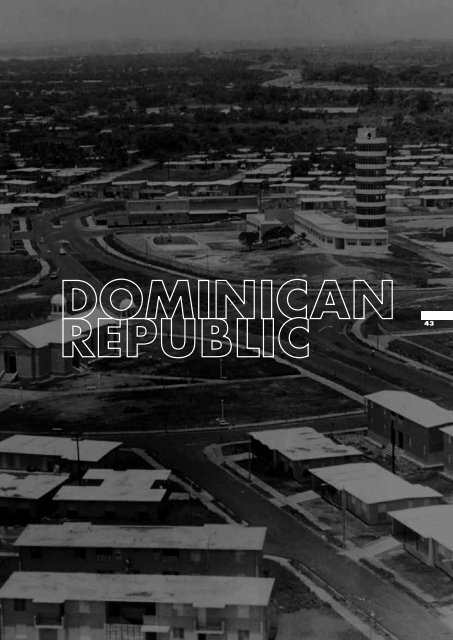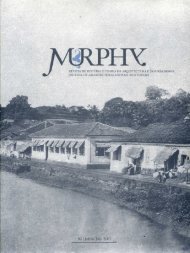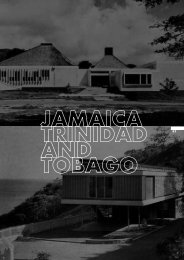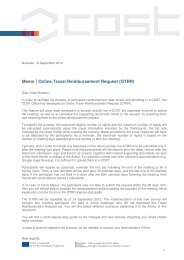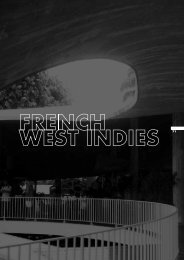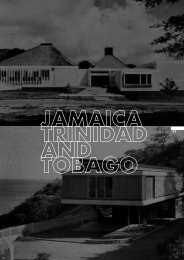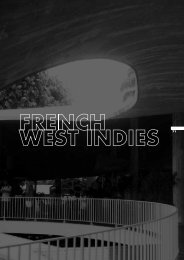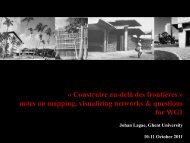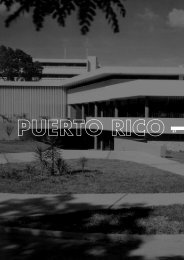Santo Domingo, Modernity and Dictatorship
Santo Domingo, Modernity and Dictatorship
Santo Domingo, Modernity and Dictatorship
Create successful ePaper yourself
Turn your PDF publications into a flip-book with our unique Google optimized e-Paper software.
<strong>Santo</strong> <strong>Domingo</strong>,<br />
<strong>Modernity</strong><br />
<strong>and</strong> <strong>Dictatorship</strong><br />
OMAR RANCIER<br />
In the early twentieth century, <strong>Santo</strong> <strong>Domingo</strong> was a small village.<br />
When it burst its original limits of the colonial wall <strong>and</strong> of the villages<br />
of San Carlos to the North <strong>and</strong> of Pajarito on the east bank of the Ozama<br />
River, those peripheral settlements became part of the Republic’s capital.<br />
AT THAT TIME, the modern movement was underdeveloped<br />
in <strong>Santo</strong> <strong>Domingo</strong>. Meanwhile, the European masters were<br />
carrying out their works <strong>and</strong> the bauhauslers, who had<br />
fled the nazis <strong>and</strong> settled in the United States, participated<br />
in a process by which the total social content of modernity<br />
was lost, according to Colin Rowe. 1<br />
After nine years of the Trujillo nightmare the city changed<br />
its name to Ciudad Trujillo. This change was marked by<br />
the first consistently modern structure, the Copello<br />
building, erected in the emblematic Calle El Conde in<br />
1939. Thus, modernity came to <strong>Santo</strong> <strong>Domingo</strong> during<br />
the m<strong>and</strong>ate of Rafael Leonidas Trujillo Molina, the<br />
dictator who held Dominican society in his fist for three<br />
decades from 1930 to 1961. In his own person Trujillo<br />
assumed the role which the amorphous Dominican<br />
bourgeoisie did not take on, a pattern that became the<br />
usual strategy of other contemporary Latin American<br />
dictators: Pérez Jiménez in Venezuela, Machado <strong>and</strong><br />
Batista in Cuba, <strong>and</strong> Perón in Argentina. <strong>Santo</strong> <strong>Domingo</strong><br />
initiated its major modern urban projects, dividing them<br />
into two major divisions: on the one h<strong>and</strong>, public housing<br />
projects, such as the Barrios Obreros (Henry Gazón), 2 the<br />
Barrio of Maria Auziladora to the north of the city <strong>and</strong> the<br />
Barrio of Los Mina (Ramón Báez López-Penha <strong>and</strong> Pablo<br />
Mella) in the center, <strong>and</strong> on the other h<strong>and</strong>, institutional<br />
projects like the University City (José Antonio Caro<br />
Alvarez, Humberto Ruiz Castillo <strong>and</strong> André Dunoyer<br />
de Segonzac). The Fair of Peace <strong>and</strong> Fraternity of the<br />
Free World (Guillermo González), Caro’s Medical<br />
School <strong>and</strong> González’s Governmental Palace of the<br />
Federal District are emblematic works of the Dominican<br />
modern movement. Other relevant urban works are the<br />
Malecón, an enormous urban space more than twenty<br />
kilometers long, also known as the George Washington,<br />
which preserved the city’s seascape, Máximo Gómez<br />
Avenue <strong>and</strong> Fabré Gefrard Avenue <strong>and</strong> other<br />
thoroughfares, which created the first north-south axes of<br />
<strong>Santo</strong> <strong>Domingo</strong>. All these works were directed by<br />
engineer Ramón Báez López-Penha.<br />
ONLY IN THE MID 1950s, with the Regulating Plan of<br />
Ciudad Trujillo drawn up by Ramón Vargas Mera, does<br />
a vision of a modern city for <strong>Santo</strong> <strong>Domingo</strong> appear. This<br />
is in spite of two urban plans for the city, more<br />
neoclassical than modern, one of which was conceived<br />
by Guido D’Aless<strong>and</strong>ro <strong>and</strong> José Antonio Caro in 1937, 3<br />
<strong>and</strong> the other by José Ramón Lopez-Penha (1938).<br />
Virgilio Vercelloni called Lopez-Penha’s plan ‘comical<br />
<strong>and</strong> banal.’ 4 <strong>Modernity</strong> is impeded by the need to satisfy<br />
the central <strong>and</strong> hegemonic powers. So, on the one h<strong>and</strong>,<br />
projects are executed which attempt to make the city<br />
more efficient <strong>and</strong> which fulfill the requirements of<br />
motorized transportation, <strong>and</strong> on the other h<strong>and</strong>, which<br />
render the city a medium to promote the dictatorship’s<br />
power <strong>and</strong> presence.<br />
THE CREATION of a formal repertory 5 made of a full<br />
neoclassical catalogue is conceived by Henry Gazón. 6 It<br />
extends the regime’s power, from the capital to the distant<br />
<strong>and</strong> troubled frontier with Haiti.<br />
PERHAPS one of the most interesting aspects of the<br />
transition to modernity in the Dominican Republic under<br />
Trujillo’s rule is the use of a double code. This enabled<br />
53<br />
Docomomo N°33<br />
September 2005
Fig. 2. José Antonio Caro, José Ramón Báez et al, aerial photography of the campus of <strong>Santo</strong> <strong>Domingo</strong> University, circa 1945<br />
© photo Stopelman<br />
54<br />
the regime to appear as a modern, even democratic,<br />
government in its hotels, schools <strong>and</strong> hospitals, all of<br />
which are conceived <strong>and</strong> built in a mature modern idiom.<br />
On the other h<strong>and</strong>, buildings which house organs of<br />
social control, such as police detachments, court houses,<br />
fortresses <strong>and</strong> other government buildings, have an<br />
almost fascist look. Conforming to the semantics of the<br />
regime, they are called ‘palaces.’ 7<br />
THIS DOUBLE CODE also appeared in the works of some<br />
the main Dominican architects of the period, namely<br />
Guillermo González <strong>and</strong> José Antonio Caro. In his housing<br />
projects, González worked within a traditional idiom, <strong>and</strong><br />
in his institutional buildings he worked within a modern<br />
idiom, stark <strong>and</strong> of colossal scale. In his modern idiom, he<br />
was equally skillful in rotation (Hotel Jaragua) <strong>and</strong> frontalness<br />
(the Palace of the City Government of the Federal District).<br />
In his Secretariat of Education <strong>and</strong> his Central Bank, Caro<br />
does not impose himself, but rather minimizes his own<br />
personality, which results in a neoclassicism far from the<br />
modern plasticity of his Medical School of the University<br />
of <strong>Santo</strong> <strong>Domingo</strong> or from the Bauhaus rationality of the<br />
Engineering <strong>and</strong> Architecture School. 8<br />
THIS STYLISTIC INCONSISTENCY of modern architects<br />
is not exclusive to the Dominican Republic. In the preface<br />
to her fine book Malaussena: Arquitectura Academica en<br />
la Venezuela Moderna, Sylvia Hernández de Lasala,<br />
writes of the Venezuelan Luis Malaussena: “A worrying<br />
<strong>and</strong> seductive question arises which needs examination:<br />
how can a work like the headquarters of the Secretariat<br />
of the Presidency of the Republic, known as the White<br />
Palace, <strong>and</strong> of a neoclassic appearance, have been<br />
conceived at the same time as the Guaicamacuto Hotel,<br />
today the Marcuto Sheraton, <strong>and</strong> the Maracay Hotel,<br />
which are both examples of the purest international style?” 9<br />
Ever since Haussmann in the nineteenth century laid out<br />
long perspectives which were incidently also useful for<br />
controlling rebellions with grape-shot, almost all dictators<br />
have preferred imposing projects <strong>and</strong> gr<strong>and</strong> avenues in<br />
their urban plans. 10 We see this in Caracas in the<br />
monumental works of Malaussena <strong>and</strong> in Havana in the<br />
gr<strong>and</strong> avenues designed by Forestier. In <strong>Santo</strong> <strong>Domingo</strong>,<br />
during the consolidation of modernity which occurred<br />
during the Trujillo period, there was no structured will<br />
expressed in a master plan. Rather, what occurred was a<br />
series of unstructured works which fulfilled very defined<br />
needs but which in the end orchestrated a proposal for a<br />
modern city.<br />
The engineer Ramón Báez López-Penha wrote about<br />
the urban regulations enacted to remedy the effects<br />
of the 1930 hurricane San Zenon: “let us continue<br />
assembling housing developments mechanically <strong>and</strong><br />
uncreatively without any plan or specific goal so that<br />
we can continue to lack what we lack today, that is,<br />
clear <strong>and</strong> precise plans to guide us.” 11<br />
The direction of Máximo Gómez Avenue, also planned<br />
by Báez, demonstrated this lack of structural vision<br />
Docomomo N°33<br />
September 2005
when the construction of General Andrews airport<br />
mutilated this avenue’s north-south line. This axis was<br />
completed only in the final years of the dictatorship<br />
when the airport was moved to Cabo Caucedo, its<br />
present location, thirty kilometers east of the city. This<br />
group of traffic arteries was completed with a project<br />
which became the paradigm of the Trujillo era’s<br />
architecture <strong>and</strong> urbanism: the Fair of Peace <strong>and</strong><br />
Fraternity of the Free World, completed in record time in<br />
1955 to celebrate the twenty-fifth anniversary of the<br />
regime. It was designed by Guillermo González Sánchez<br />
<strong>and</strong> was influenced by the EUR 42 <strong>and</strong> the University of<br />
Rome. 12 Caro’s plan for the University of <strong>Santo</strong> <strong>Domingo</strong><br />
(in collaboration with Humberto Ruiz <strong>and</strong> the French<br />
designer of the Basilica of Higuey, Dunoyer de Segonzac)<br />
dates from this period.<br />
IT SHOULD BE POINTED OUT that Caro’s urban schemes<br />
for the University <strong>and</strong> González’s for the Fair recognize<br />
the postulates of modern urbanism. They are particularly<br />
axial, defined by the two main axes with their<br />
monumental end points, the Alma Mater building at the<br />
University <strong>and</strong> the Plaza of the Nations (better known as<br />
‘the little ball of the world’) at the fair. The modernity of<br />
Fig. 3. Guillermo González et al, aerial photography of the Fair of Peace <strong>and</strong> Fraternity of the Free World, <strong>Santo</strong> <strong>Domingo</strong>, 1955<br />
55<br />
© photo Stopelman<br />
Fig. 4. Rafael Tomás Hernández, urban development<br />
of the barrio de Honduras, <strong>Santo</strong> <strong>Domingo</strong>, 1966<br />
Fig. 5. Rafael Tomás Hernández, urban development<br />
of the barrio del Hoyo de Chulín, <strong>Santo</strong> <strong>Domingo</strong>, 1988<br />
Docomomo N°33<br />
September 2005
56<br />
these ensembles is seen in the design of their buildings<br />
<strong>and</strong> in their urban installations, but not in their conception<br />
of space or their management of vehicular traffic.<br />
Trujillo compromised Dominican modernity when he<br />
commissioned a catalogue of works representing the<br />
regime throughout the country. Gázon Bona created a<br />
‘Trujillista’ typology of Dominican architecture in a series<br />
of projects in San Cristobal, where he built hotels,<br />
housing projects <strong>and</strong> schools; in Santiago with his<br />
Monument to Peace of Trujillo <strong>and</strong> dozens of ‘palaces;’<br />
<strong>and</strong> in the frontier region where he designed hotels,<br />
barracks, municipal government buildings, law courts<br />
<strong>and</strong> branch offices of the Dominican party.<br />
<strong>Santo</strong> <strong>Domingo</strong> never had a structured vision of a modern<br />
city (or to be exact, of any kind of city), unlike Cuba<br />
during Machado’s dictatorship, for whom Forestier<br />
worked, as he also did in Argentina. 13 In reality, the city’s<br />
urban project appears to be only the sum of independent<br />
<strong>and</strong> punctual works, linked to the city to optimize <strong>and</strong><br />
adapt it to the new times without touching to the historical<br />
center, as José Lluís Sert proposed for Havana in 1959. 14<br />
The architect Ramón Vargas Mera, author of the<br />
Regulating Plan for <strong>Santo</strong> <strong>Domingo</strong> in 1956 recognized<br />
a bit of this when he wrote: “Demolishing the historical<br />
center <strong>and</strong> building towers in its place is not what is<br />
proposed. The center is to be respected, with its<br />
architectural <strong>and</strong> urban values.” 15<br />
Vargas Mera was the only one to dem<strong>and</strong> a vision of a<br />
modern city for <strong>Santo</strong> <strong>Domingo</strong>. Nevertheless, his vision<br />
questioned orthodox modern urbanism, as he noted<br />
when writing about the plan: “The system of zoning<br />
according to function, central to the CIAM <strong>and</strong> the Athens<br />
Charter, is to be substituted by a system of mixed zoning<br />
in which the predominant activity will stimulate the<br />
character of the zone <strong>and</strong> secondary activities will<br />
complement the zone’s use.” 16<br />
The fact that Vargas Mera’s plan was rejected, once it<br />
conflicted with the regime’s political interests, reaffirmed<br />
the refusal of political will to conceive of the city as an<br />
integrated whole. This attitude continues today.<br />
AFTER THE FALL of the Trujillo regime in 1961, <strong>Santo</strong><br />
<strong>Domingo</strong> recovered its name <strong>and</strong> became an open city<br />
which continues to enforce its vision of modernity.<br />
However, it has still not drawn up a master plan, <strong>and</strong> we<br />
continue to hope to see it converted into a better city.<br />
Although modernism was practiced during the Trujillo<br />
era, a modern city, participatory, functional <strong>and</strong><br />
democratic, remains to be constructed. Joaquín Balaguer,<br />
elected president with the support of the invading troops<br />
of the Organization of American States, was more<br />
interested in the colonial city, bad housing <strong>and</strong> large<br />
parks. Nor have subsequent governments really involved<br />
themselves in the city. And so, after five centuries, <strong>Santo</strong><br />
<strong>Domingo</strong>, lying by the Ozama River, still awaits a<br />
contemporary identity, which has yet to arrive.<br />
OMAR RANCIER, architect, graduated cum laude from the University<br />
Autónoma of <strong>Santo</strong> <strong>Domingo</strong> in 1979. President <strong>and</strong> founder of the<br />
group Neuvarquitectura, organizer of architectural biennials in <strong>Santo</strong><br />
<strong>Domingo</strong>, author of numerous articles <strong>and</strong> essays in <strong>Santo</strong> <strong>Domingo</strong>'s<br />
major specialist journals, professor at the school of architecture at<br />
the University Pedro Henríquez Ureña (UNPHU). Omar Rancier was also<br />
director of the Faculty of Architecture at the University Iberoamericana<br />
(UNIBE).<br />
Translated by Jon Kite<br />
NOTES<br />
1 Colin Rowe, Fred Koeter, Ciudad Collage (Barcelona: GG, 1981), 34.<br />
2 Eugenio Pérez Montas, La Ciudad del Ozama (Barcelona: Patronato<br />
de la Ciudad Colonial de <strong>Santo</strong> <strong>Domingo</strong> & Centro de Altos Estudios<br />
Humanísticos y del Idioma Español, 1999), 284.<br />
3 Ibid., 283. Taken from J. Chez Checo, El Palacio Nacional de<br />
la República Dominicana: 50 Años de historia y arquitectura (<strong>Santo</strong><br />
<strong>Domingo</strong>: Secretaria Administrativa de la Presidencia, 1997).<br />
4 Virgilio Vercelloni, Atlas Histórcio de <strong>Santo</strong> <strong>Domingo</strong> (Milan:<br />
Cosmopoli, 1991).<br />
5 Architect Ramón Martinez, “El Significado de la Arquitectura de<br />
la Era de Trujillo,” paper presented at Arquitectura Contemporanea<br />
en la República Dominicana, organized by the Grupo<br />
Nuevarquitectura (Casa de Teatro, September 4–6, 1981).<br />
6 “In its time, by which it was inspired, the typical neoclassicism was<br />
born, which was extremely characterized by its lines. These limpid<br />
creations resemble a past overflowing with tradition <strong>and</strong> nationality.”<br />
Henry Gazón Bona, La Arquitectura Dominicana en la Era de Trujillo<br />
(Collection Henry Gazón Bona, 1949), 1.<br />
7 Architect Ramón Martinez, “El Significado de la Arquitectura de<br />
la Era de Trujillo,” paper presented at Arquitectura Contemporanea<br />
en la República Dominicana, organized by the Grupo<br />
Nuevarquitectura (Casa de Teatro, September 4–6, 1981).<br />
8 Omar Rancier, “Versatilidad estilistica en la Arquitectura<br />
de Guillermo González,” Nuevarquitectura 43, El Siglo (February 23,<br />
1990): 6B.<br />
9 Silvia Hernández de Lasala, Malaussena: Arquitectura Academica<br />
en la Venezuela Moderna (Caracas: Editorial ExLibris, 1990), 20.<br />
10 Leonardo Benevolo, Historia de la Arquitectura Moderna<br />
(Barcelona: Gustavo Gili, 1982), 100.<br />
11 Engineer José R. Báez López-Penha, “<strong>Santo</strong> <strong>Domingo</strong>:<br />
Su Fundación y Crecimiento,” paper presented at the round table<br />
on urban planning (National University Pedro Henriquez Ureña,<br />
July 6–8, 1972). Codia 26, May/August 1971.<br />
12 Gustavo Luis Moré, “Guillermo González: A los 82 años de<br />
su nacimiento,” Hoja de Arquitectura 26, “El Nuevo Diario”<br />
(November 1, 1982).<br />
13 Jean-François Lejeune, “The City as L<strong>and</strong>scape: Jean Claude<br />
Nicolas Forestier <strong>and</strong> the Great Urban Works of Havana,<br />
1925–1930,” The Journal of Decorative <strong>and</strong> Propag<strong>and</strong>a Arts 22<br />
(Cuba, 1996): 165.<br />
14 Mario Coyula, “Influencias Cruzadas Cuba/EUU en el medio<br />
construido: Carril dos, o autopista en dos sentidos?,” Archivos<br />
de Arquitectura Antillana, Year 5, No. 10 (June 2000): 121.<br />
15 Ramón Vargas Mera, “Tendencias Urbanisticas in America Latina<br />
y el Caribe: La Situacion a Finales del Siglo XX,” Amigo del Hogar<br />
(<strong>Santo</strong> <strong>Domingo</strong>, 2004): 73.<br />
16 Ibid.<br />
Docomomo N°33<br />
September 2005


